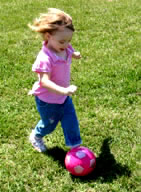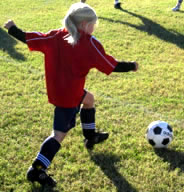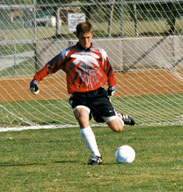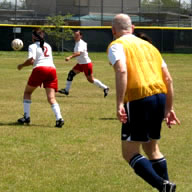Thomas J. Parr, M.D., F.A.C.S.
| ||||||
| WELCOME • ABOUT DR. PARR
• PATIENT INFO • en español SPORTS MEDICINE • ARTICLES/LINKS • CONTACT US • PAY YOUR BILL ONLINE |
||||||
|
||||||||
SoccerSoccer is a sport that is well known worldwide and universally played. Almost 20 years ago on a family vacation cruise, our sons bought a soccer ball in a small island village. None of us could speak the language, so we walked through the streets towards the community soccer field holding the ball up over our heads. By the time we reached the field, we had a great pick-up game! The history of Soccer goes back many centuries. King Edward of England (1307-1327) did not like the game at all, which he regarded as being most uncivilized. Indeed, he was correct. The game often became a melee between whole villages, which could go on back and forth through the fields, streams, and countryside for days, and pretty much without any rules. Over the next several centuries, other kings and queens tried to ban it, as well, also without success. In the 1800’s, a little more order and dignity was finally created. In 1863, the newly formed English Football Association established a basic set of rules, which included not using hands and no tripping of opponents. In 1866, the first "off sides" rules were passed. Also in 1866, for a competition between London and Sheffield, the two sides agreed in advance to limit the game to 90 minutes. The popularity of soccer grew internationally, and the Fédération Internationale de Football Association (FIFA) was founded in Paris in May,1904. The first FIFA World Cup competition was played Uruguay in 1930. Today, soccer has become a very popular American sport to play. Starting about 40 years ago, it often became the sport of choice for parents seeking a good form of aerobic exercise for their children in a team setting. Part of that appeal was that the consequences of serious injuries to their children were less likely than some of their other options. Many of these children are now the parents and coaches for their own young children. Soccer can be played by all ages, starting as early as the pre-kindergarten years, and well into the senior years. Physical size, height, and body build are not limiting factors, as long as you can be in good enough shape to run, sprint, make quick stops and starts, kick, jump, and otherwise participate. As a team sport, technical skill, individual speed, agility, and mental anticipation are required of all the team's member in order for the team to be successful. The play is essentially non-stop for long periods of time, requiring substantial endurance and personal conditioning. During the 90 minutes of the game, professional players can cover as much as 6 to 8 miles running back and forth! FIELD & EQUIPMENT: Currently FIFA only permits soccer fields to have grass (natural turf). While artificial turf is easier to maintain, it can alter the game and lead to additional injury risks. For these reasons, artificial turf is not preferred for a soccer field. Under normal weather conditions, hand stitched leather balls are preferred. While you will want to save your best ball for games, practice balls need to be comparable so the players are practicing a realistic touch on the ball. Under wet conditions, synthetic balls will not become water-logged, so that might be a consideration when the pitch is wet. Of course, most recreational soccer fields are closed when the fields are too wet, meaning practices are cancelled or games must be rescheduled. Maintaining a field in good condition is important to prevent unnecessary risks for injury. Trash and debris should not be permitted on the field. Bare spots need to be reseeded, and uneven surfaces and holes need to be filled in and leveled. To protect players, especially the goalkeeper, the soccer goal frames should be well secured in the ground. Padding the front sides and upper cross bar is reasonable in recreational programs, as well. All players should be taught never to hang from the frame of the goal. PLAYER’S PERSONAL EQUIPMENT: As players move up to more advanced teams, the number of shoes needed for play will increase. At a higher level of competition, players will want different kinds of cleats to play on a greater variety of playing surfaces. Only at this level should screw-in cleats be considered, and only for play on wet fields or fields with high grass. This is because the screw-in cleats are more apt to cause injury to other players. Screw-in cleats also provide a greater risk for ankle injuries for the wearer. Shoes should be tried on with the socks to be worn in practices and games. Soccer players often wear two pair of socks - one to wick away moisture and protect the feet from blisters, and a second outer pair which is part of the uniform. Shin guards are required to protect the lower legs. They do make a difference. Players are usually able to continue play when kicked almost as if not much had happened. And interestingly, after shin guards became mandatory, I noticed a distinct drop in broken legs in my office, even in situations where two players would fall on each other. Goalkeepers need to have gloves appropriate for their size and age which will help protect fingers and assist in holding on to the ball. Goalkeepers also should use specially designed goalkeeper uniforms with padding to help protect the player while making a diving "save". Soccer will be played on both hot and cold days. For cold days, players will need an extra layer of cold weather clothing on under the uniform. Check with the coach to learn exactly what is permitted in league rules before making cold weather purchases. (Parents should be forewarned that you also will want to have protective clothing for yourselves for both cold and wet games. The players are at least running. You will be sitting and standing.) PRE-SEASONING CONDITIONING: If you haven't received an off-season workout program from your coach, ask for one or develop one on your own. Starting at about four to six weeks prior to the start of your first practice, it is time to really concentrate on getting into shape. Determine how long you can safely run as your starting point. Do your aerobic training for that amount of time for the first week. Increase your workout time by 10 minutes each week, until you are doing a full hour without undue stress. Then hold your aerobic workout time consistently at 60 minutes until the start of the season. For endurance, you need to concentrate on aerobic fitness by running, mixed with jogging and sprinting. Remember to always stay well hydrated. To provide better protection against injuries, work on both strength and flexibility of the muscles in your legs and ankles. For players over the age of 14, light weight training will help keep you from being pushed off the ball. If you have not done weight training before, it is a good idea to start with a few sessions with a professional trainer to learn correct form. Otherwise, your weight training might end up doing more harm than good. To improve proprioception, balance, and ankle strength, walk forwards and backwards for a few minutes every day on the curb or on a 2x4 or 2x6 plank. To improve your ball handling skills, practice juggling and dribbling. Practice simple ball passing with a friend several times a week. Get a good night's sleep every night. Sleep is important in helping your body recover from strenuous exercise. INJURIES: Children and adolescents are more likely to have overuse injuries because of their rapid growth spurts. If players in this age group complain about pain when the game or practice is over and they have had a chance to clean up, it should be checked by a doctor. You don’t want to take a chance on damaging the growth plates of the bones. Inflammation or other problems involving the tendons, especially where they attach to bone, do need medical evaluation, and if necessary, treatment. Pain along the shin, along the Achilles tendons. or in the feet also should be checked by a doctor, and take your shoes with you for your doctor’s appointment. The more likely cause for this pain would be overuse, due to lack of conditioning prior to the start of the season, and also perhaps due to your shoes. Shin splints, small stress fractures, and Achilles tendonitis can generally be treated without having to sit out practices and games; but if ignored, it is possible for the condition to become a more serious non-displaced fracture or a full Achilles tendon rupture, taking a player out for several weeks or months. Overuse injuries involving the thigh and hip may be due to a lack of flexibility of the iliotibial band or the hamstring. They also can result when the quadriceps muscles are overdeveloped, compared to the hamstrings. Good pre-season training should include work on stretching to increase flexibility and to strengthen the hamstring. While not a collision sport, soccer is a contact sport. Players will run into each other, sometimes on purpose and other time unavoidably. If the referee is really in charge of the game and if players are in good physical shape, the chances of getting hurt should be reduced. Superficial contusions will heal and playing time is not apt to be lost. Really deep contusions, such as a blow to the thigh which takes a player out of the game, does need to be checked by a doctor to watch for possible blood clots. Ankle and knee injuries are the two most common locations for soccer injuries, sometimes forcing the player to come out of a game or sit out a practice. If so, a doctor needs to check these before a player returns to the game to be sure he or she isn’t a set-up for an even worse injury shortly. The most devastating injury I see in professional and recreational soccer players is a torn anterior cruciate ligament ACL. ACL tears occur between 6 and 8 times more frequently in women players than men at the same level of competition. The National Athletic Trainer's Association (NATA) and the American Academy of Orthopedic Surgeons (AAOS) have an initiative to address this problem. Please see the NATA Consensus Statement on ACL injuries for more information. (Every coach needs to be certified in CPR. The NATA can provide additional provide information, on CPR training, as well.) Toe injuries are sometimes unavoidable, such as when another player steps on your foot. But others can be managed by being sure the toe box of the shoe has enough room and keeping toenails trimmed. Knowing exactly where you foot is in relation to both the ball and the ground will help prevent "turf toe". This can happen at all ages, but is a special consideration for young players going though a growth spurt. The best way to know where your foot is comes only with regular shooting and passing practice. Occasionally, a player will take a fall in such a way - and with enough force - to break an arm or wrist or to dislocate a shoulder. These will require emergency treatment by an emergency room physician or an orthopedic surgeon. During hard fought games, two players occasionally will go up for a "header" at the same time, and in the process collide heads. It has even happened to me, and I was treating patients with a big bruise on my face for about a week. For a number of hours after such an accident, pay close attention to the player to be sure he or she didn't get a concussion. If you suspect something might be wrong, seek emergency medical care. Goalkeepers have an increased chance for some injuries, including upper body injuries. It therefore is important for goalkeepers to have special training on proper, safer, and more effective goalkeeping techniques. Knowing how to catch, block, dive and land correctly will help reduce the chances of upper body injuries, including wrist, arm, elbow, and shoulder injuries. Goalkeepers can protect their fingers by using goalkeeping gloves which are appropriate for their age and size. HYDRATION & DIET: Diet has an effect on conditioning during the soccer seasons. Daily meals need to be primarily proteins, vegetables, and complex carbohydrates. Their bodies are needing these nutrients to aid in recovery from the high energy pace of the soccer season. A RECOMMENDED COACH'S RESOURCE: — Tom Parr, M.D. |
COMMON SPORTS INJURIES & SAFE PARTICIPATION
Baseball & Softball
SPORTS MEDICINE RECOGNITION
Recognized as one of the "Top Sports Medicine Orthopedic Surgeons in the USA" by Castle Connolly. Dr. Parr has been named as an "Outstanding Orthopedic Surgeon of Texas", as seen in SPORTS ILLUSTRATED.
SPEAKER'S PROGRAM:
|
|||||||
| 14090 Southwest Freeway #130 Sugar Land TX 77478 Phone: 281-491-7111 |
© Copyright 2009-2018 Thomas J. Parr, M.D. |





